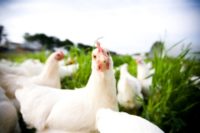In a move that surprised and pleased food and worker safety advocates, the USDA has denied a bid by the U.S. poultry industry to allow inspection lines to speed up. It was the second defeat for the National Chicken Council (NCC), which had attempted to get the limit raised under the Obama administration.
Citing the need for increased productivity in order for the industry to remain competitive, the NCC had asked the USDA to allow meatpackers operating under the controversial New Poultry Inspection System (NPIS) to run their plants "at any line speed" they deemed appropriate. The change would have given companies considerable latitude over worker safety and food contamination concerns.
Didn't provide data
In its denial, the USDA said the poultry industry "did not include data to demonstrate that inspectors can conduct an effective carcass-by-carcass inspection at line speeds faster than those authorized" under the new inspection system.
Advocacy group Food & Water Watch had opposed the NPIS – calling it “a dramatic change” that allowed companies to inspect themselves and left only one USDA inspector on each slaughter line. The “only positive” in the rule, according to the group, was the 140 birds per minute cap on line speeds – the cap the NCC wanted to eliminate.
“Even at 140 bpm, a lone USDA inspector is checking 2.33 birds every second under NPIS as opposed to the one bird every two seconds under the traditional inspection system,” said Food and Water Watch in a statement.
About the NPIS
The NPIS is based on a 15-year pilot program that the agency conducted in 25 poultry plants – 20 chicken and five turkey facilities – that permitted those plants to operate at higher line speeds with fewer USDA inspectors stationed on the slaughter lines.
Many of the safety and health hazards to which poultry workers are exposed, such as dangerous equipment, slippery floors, musculoskeletal disorders, and hazardous chemicals (including ammonia that is used as a refrigerant) are potentially increased by an increase in the speed at which they are required to process the poultry.
The USDA said it would consider granting a limited number of waivers to individual plants to allow line speeds of up to 175 birds per minute – which the National Chicken Council said was encouraging.


